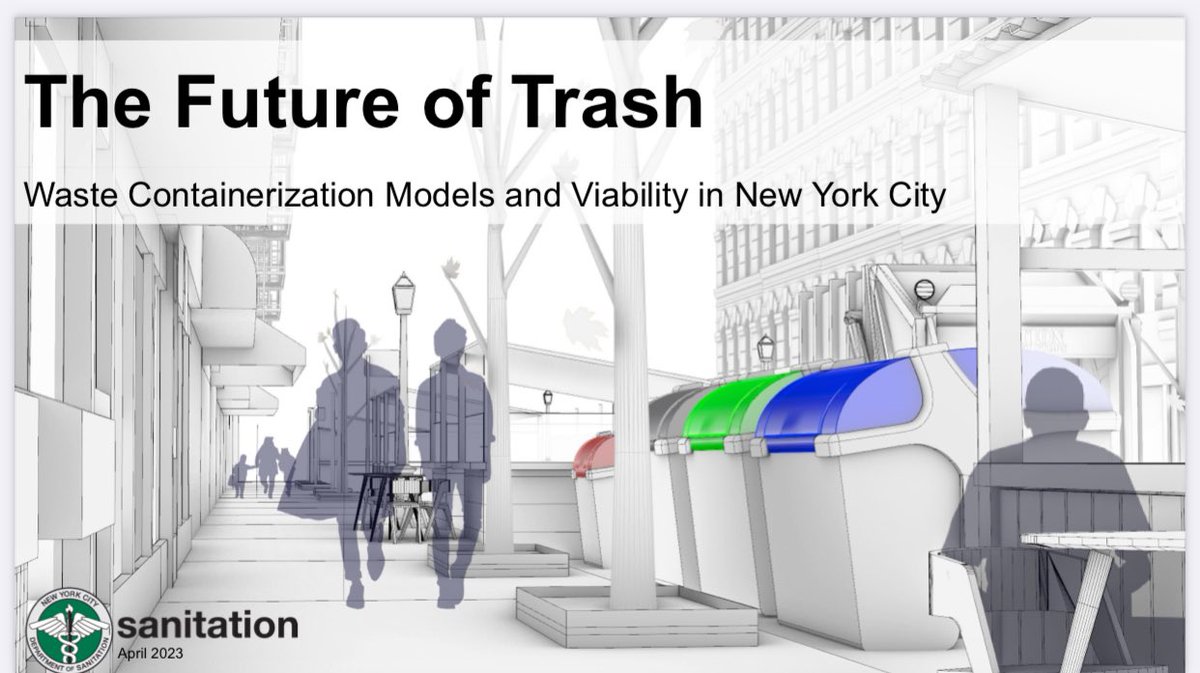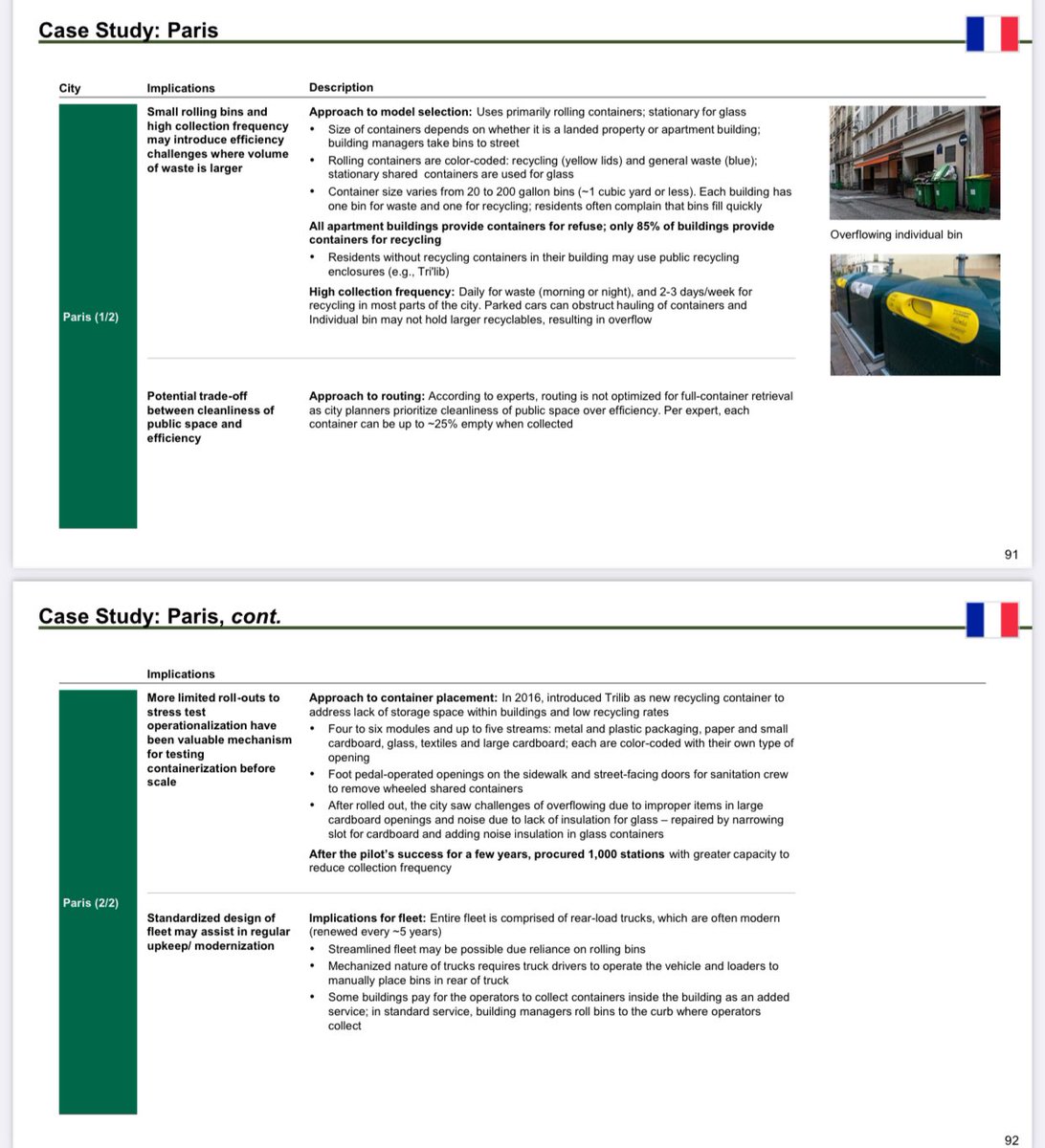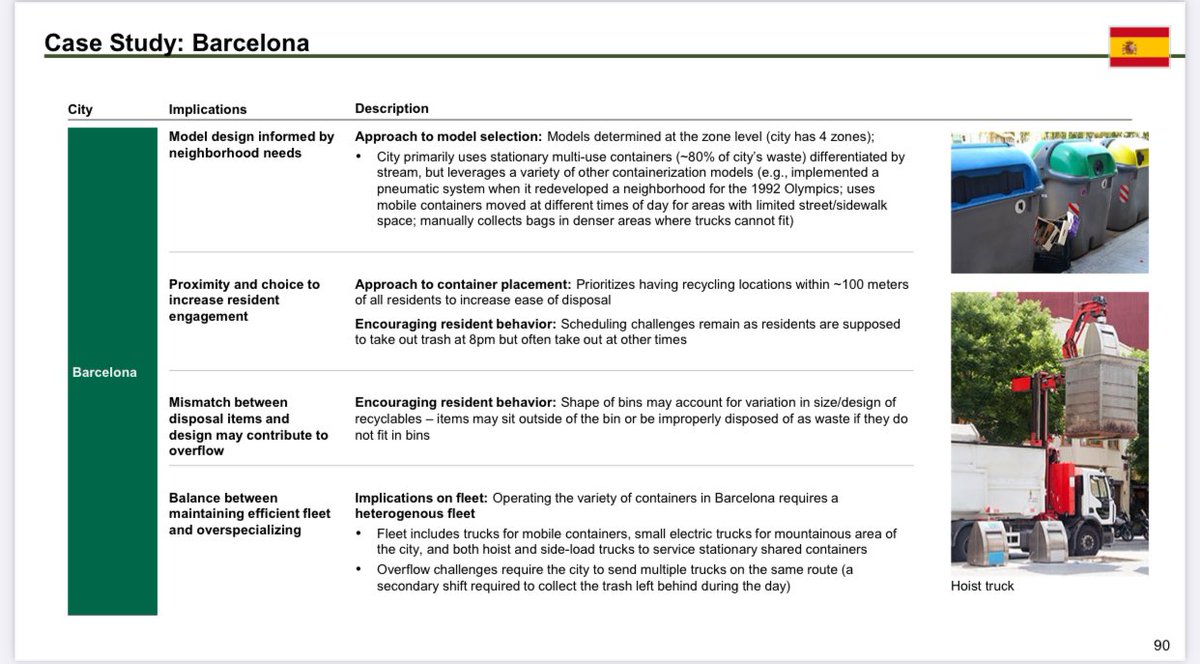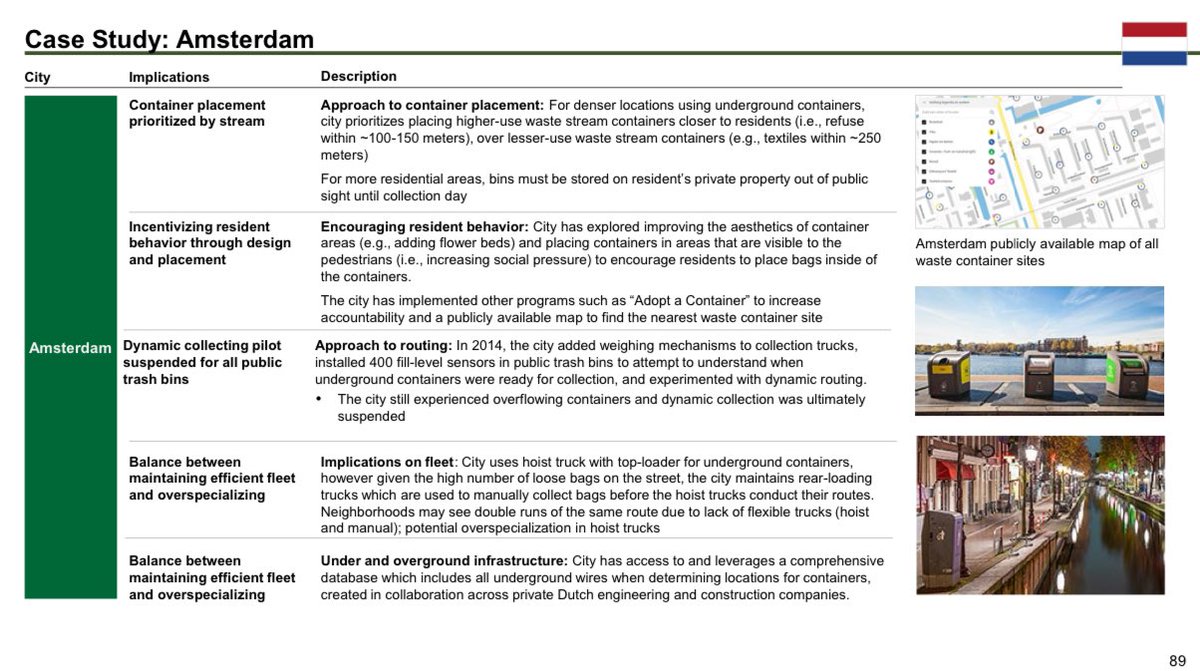
Trung Phan@TrungTPhan
Jul 9, 2024
5 tweets
New York City paid Mckinsey $4m to conduct a feasibility study on whether trash bins are better than leaving garbage on the street.
The deck is 95-slides long and titled “The Future of Trash”.
Some highlights:
 The official term is “containerization”, which is the “storage of waste in sealed, rodent-proof receptacles rather than in plastic bags placed directly on the curb.”
The official term is “containerization”, which is the “storage of waste in sealed, rodent-proof receptacles rather than in plastic bags placed directly on the curb.”
 Two main types of containerization: 1) individual bins for low density locales; 2) shared containers for high-density.
Two main types of containerization: 1) individual bins for low density locales; 2) shared containers for high-density.
 NYC needs to clean up 24,000,000lbs of garbage a day
NYC needs to clean up 24,000,000lbs of garbage a day
 Containerization has only become the norm worldwide in major cities in the past 15 years.
Containerization has only become the norm worldwide in major cities in the past 15 years.
 New York City first considered containerization in the 1970s but never conducted a feasibility study until now (Mckinsey’s sales team has been dropping the ball)
New York City first considered containerization in the 1970s but never conducted a feasibility study until now (Mckinsey’s sales team has been dropping the ball)
 Key considerations for container viability:
• POPULATION DENSITY: NYC has 30k residents per square mile (more dense than comparable big cities)
• BUILT ENVIRONMENT: Few places to “hide” containers due to history of infrastructure development.
• WEATHER: Snow creates challenges for “mechanized collection” in the winter.
• CURB SPACE: Mostly taken up by bus stops, bike lanes, outdoor dining and fire hydrants.
• COLLECTION FREQUENCY: NYC needs to double frequency of pick-up for estimated speed of trash that bins would accumulate.
• FLEET: A new garbage truck will needs to be designed to collect rolling bins at scale.
Key considerations for container viability:
• POPULATION DENSITY: NYC has 30k residents per square mile (more dense than comparable big cities)
• BUILT ENVIRONMENT: Few places to “hide” containers due to history of infrastructure development.
• WEATHER: Snow creates challenges for “mechanized collection” in the winter.
• CURB SPACE: Mostly taken up by bus stops, bike lanes, outdoor dining and fire hydrants.
• COLLECTION FREQUENCY: NYC needs to double frequency of pick-up for estimated speed of trash that bins would accumulate.
• FLEET: A new garbage truck will needs to be designed to collect rolling bins at scale.
 The proposed solution (literally garbage bins and shared containers) covers 89% of NYC streets and 77% of residential tonnage.
The proposed solution (literally garbage bins and shared containers) covers 89% of NYC streets and 77% of residential tonnage.
 The three case studies — because you gotta have solid case studies — are Amsterdam, Paris and Barcelona.
The three case studies — because you gotta have solid case studies — are Amsterdam, Paris and Barcelona.
 There is a slide called “Why containerization matters” and three reasons are “rats”, “pedestrian obstruction” and “dirty streets” (the 21-year intern that did this slide billed at prob $10k an hour is my hero).
The study is actually pretty interesting.
I have no idea if $4m is a rip-off to learn that “yeah, we should put garbage in bins so rats don’t eat it” but I would have happily done it for 10-20% of that budget (and come to a similar conclusion).
There is a slide called “Why containerization matters” and three reasons are “rats”, “pedestrian obstruction” and “dirty streets” (the 21-year intern that did this slide billed at prob $10k an hour is my hero).
The study is actually pretty interesting.
I have no idea if $4m is a rip-off to learn that “yeah, we should put garbage in bins so rats don’t eat it” but I would have happily done it for 10-20% of that budget (and come to a similar conclusion).
 The official term is “containerization”, which is the “storage of waste in sealed, rodent-proof receptacles rather than in plastic bags placed directly on the curb.”
The official term is “containerization”, which is the “storage of waste in sealed, rodent-proof receptacles rather than in plastic bags placed directly on the curb.”
 Two main types of containerization: 1) individual bins for low density locales; 2) shared containers for high-density.
Two main types of containerization: 1) individual bins for low density locales; 2) shared containers for high-density.
 NYC needs to clean up 24,000,000lbs of garbage a day
NYC needs to clean up 24,000,000lbs of garbage a day
 Containerization has only become the norm worldwide in major cities in the past 15 years.
Containerization has only become the norm worldwide in major cities in the past 15 years.
 New York City first considered containerization in the 1970s but never conducted a feasibility study until now (Mckinsey’s sales team has been dropping the ball)
New York City first considered containerization in the 1970s but never conducted a feasibility study until now (Mckinsey’s sales team has been dropping the ball)
 Key considerations for container viability:
• POPULATION DENSITY: NYC has 30k residents per square mile (more dense than comparable big cities)
• BUILT ENVIRONMENT: Few places to “hide” containers due to history of infrastructure development.
• WEATHER: Snow creates challenges for “mechanized collection” in the winter.
• CURB SPACE: Mostly taken up by bus stops, bike lanes, outdoor dining and fire hydrants.
• COLLECTION FREQUENCY: NYC needs to double frequency of pick-up for estimated speed of trash that bins would accumulate.
• FLEET: A new garbage truck will needs to be designed to collect rolling bins at scale.
Key considerations for container viability:
• POPULATION DENSITY: NYC has 30k residents per square mile (more dense than comparable big cities)
• BUILT ENVIRONMENT: Few places to “hide” containers due to history of infrastructure development.
• WEATHER: Snow creates challenges for “mechanized collection” in the winter.
• CURB SPACE: Mostly taken up by bus stops, bike lanes, outdoor dining and fire hydrants.
• COLLECTION FREQUENCY: NYC needs to double frequency of pick-up for estimated speed of trash that bins would accumulate.
• FLEET: A new garbage truck will needs to be designed to collect rolling bins at scale.
 The proposed solution (literally garbage bins and shared containers) covers 89% of NYC streets and 77% of residential tonnage.
The proposed solution (literally garbage bins and shared containers) covers 89% of NYC streets and 77% of residential tonnage.
 The three case studies — because you gotta have solid case studies — are Amsterdam, Paris and Barcelona.
The three case studies — because you gotta have solid case studies — are Amsterdam, Paris and Barcelona.
 There is a slide called “Why containerization matters” and three reasons are “rats”, “pedestrian obstruction” and “dirty streets” (the 21-year intern that did this slide billed at prob $10k an hour is my hero).
The study is actually pretty interesting.
I have no idea if $4m is a rip-off to learn that “yeah, we should put garbage in bins so rats don’t eat it” but I would have happily done it for 10-20% of that budget (and come to a similar conclusion).
There is a slide called “Why containerization matters” and three reasons are “rats”, “pedestrian obstruction” and “dirty streets” (the 21-year intern that did this slide billed at prob $10k an hour is my hero).
The study is actually pretty interesting.
I have no idea if $4m is a rip-off to learn that “yeah, we should put garbage in bins so rats don’t eat it” but I would have happily done it for 10-20% of that budget (and come to a similar conclusion).It is actually an interesting deck. Just the thought of a 20-year old newly grad getting billed at an obscene rate to say”rats get to garbage” is kinda funny
Four more solid slides:
— By the numbers (daily garbage = 140 Statue of Liberty a day!!)
— City comparison
— Container comparison (looks like they did select the “scalable” trash bin)
— Curb side analysis
Full deck here: dsny.cityofnewyork.us/wp-content/upl

Liam Quigley@_elkue
Jul 08 24
View on Twitter
“Welcome to our trash revolution.” Mayor Adams introduces the new bin that buildings with 1-9 units will be required to use instead of loose bags of garbage
Think Mckinsey telling NY to “put garbage in bins so rats don’t eat it and people can walk” will work out better than when it told AT&T in 1981 that cellphones would be “niche.”
That cost AT&T $13B and one worst business predictions ever as I wrote here: readtrung.com/p/the-worst-te
Put it in the Louvre
Here’s the full link again: dsny.cityofnewyork.us/wp-content/upl
And enjoy these case studies for Paris, Amsterdam and Barcelona.

Trung Phan
@TrungTPhan
Write on business with @workweekinc. Co-host @niapodcast. Building an AI research app: https://t.co/fZ5ObIyBGI
Missing some tweets in this thread? Or failed to load images or videos? You can try to .












